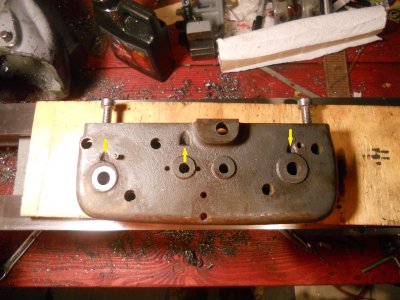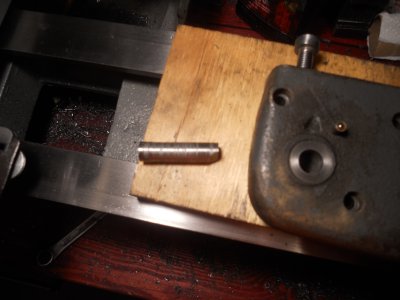This is for those interested in removing the oilers found in the front face of the Apron of an Atlas 10" or 12" models. On the 10F-9A castings, there are three,

The middle one can be easily removed from the rear using an appropriately sized punch and a dead blow hammer. And by easily, just barely tapping it should send it flying out. The other two require a bit more finesse. The holes they occupy are drilled into the through holes for the handwheel and the half-nut locking lever. This method will require that you remove both of those prior to removing the oiler.
When dismantling the half-nut carriage, you'll find the steel ball and spring that rest in a detent on the upper half-nut. Retain the steel ball for use later. There is another steel ball located in the apron, this one is used in the engaging handle for the power crossfeed. Removal of the handle and gear will net you another steel ball and spring.
The last two items needed are a small flat head screwdriver, and a short piece (1.5"-2" of 1/2" round turned down slightly to ensure an easy slip fit into the holes for the handwheel and half-nut lever (.010"-.015" should be plenty). One end should have a shallow angle ground into it approximately 30º or thereabouts, it isn't critical, just bear in mind, more of a gradual climb is better.

Depending on how much debris has accumulated in the oiler hole, the next step may be a touch difficult. Put the first steel ball into the oiler hole, using the flat head screw driver to push it down slightly, if it goes all the way, so much the better. Put the second ball in, it will rest in what is now just a shallow depression. From the backside of the apron insert the angled round with the angle flat facing the steel ball. Carefully put it into position over the steel ball, and if the ball sits low enough then light taps with a dead blow hammer should send the ball deeper into the hole. If it isn't quite low enough, use the flathead screwdriver braced against the flat angle to drive the ball down. After the second ball is forced down, the oiler should be either pushed completely out, or just barely hanging in there. Using the screwdriver or a small punch, lever the last ball deeper into the hole to finish forcing the oiler out.
![DSCN0551[1].JPG DSCN0551[1].JPG](https://www.hobby-machinist.com/data/attachments/25/25621-cdeb957d0b8e1ea7c01c1d6759d90755.jpg)
The steel balls were measured at .185 with a digital micrometer. So if you happen to have some 3/16" steel balls, they should work adequately without having to remove the crossfeed handle.
Terry


![DSCN0551[1].JPG DSCN0551[1].JPG](https://www.hobby-machinist.com/data/attachments/25/25621-cdeb957d0b8e1ea7c01c1d6759d90755.jpg)

The middle one can be easily removed from the rear using an appropriately sized punch and a dead blow hammer. And by easily, just barely tapping it should send it flying out. The other two require a bit more finesse. The holes they occupy are drilled into the through holes for the handwheel and the half-nut locking lever. This method will require that you remove both of those prior to removing the oiler.
When dismantling the half-nut carriage, you'll find the steel ball and spring that rest in a detent on the upper half-nut. Retain the steel ball for use later. There is another steel ball located in the apron, this one is used in the engaging handle for the power crossfeed. Removal of the handle and gear will net you another steel ball and spring.
The last two items needed are a small flat head screwdriver, and a short piece (1.5"-2" of 1/2" round turned down slightly to ensure an easy slip fit into the holes for the handwheel and half-nut lever (.010"-.015" should be plenty). One end should have a shallow angle ground into it approximately 30º or thereabouts, it isn't critical, just bear in mind, more of a gradual climb is better.

Depending on how much debris has accumulated in the oiler hole, the next step may be a touch difficult. Put the first steel ball into the oiler hole, using the flat head screw driver to push it down slightly, if it goes all the way, so much the better. Put the second ball in, it will rest in what is now just a shallow depression. From the backside of the apron insert the angled round with the angle flat facing the steel ball. Carefully put it into position over the steel ball, and if the ball sits low enough then light taps with a dead blow hammer should send the ball deeper into the hole. If it isn't quite low enough, use the flathead screwdriver braced against the flat angle to drive the ball down. After the second ball is forced down, the oiler should be either pushed completely out, or just barely hanging in there. Using the screwdriver or a small punch, lever the last ball deeper into the hole to finish forcing the oiler out.
![DSCN0551[1].JPG DSCN0551[1].JPG](https://www.hobby-machinist.com/data/attachments/25/25621-cdeb957d0b8e1ea7c01c1d6759d90755.jpg)
The steel balls were measured at .185 with a digital micrometer. So if you happen to have some 3/16" steel balls, they should work adequately without having to remove the crossfeed handle.
Terry


![DSCN0551[1].JPG DSCN0551[1].JPG](https://www.hobby-machinist.com/data/attachments/25/25621-cdeb957d0b8e1ea7c01c1d6759d90755.jpg)
